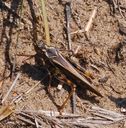Spharagemon
Spharagemon
Classification
- Phylum: Arthropoda
- Subphylum: Hexapoda
- Class: Insecta
- Order: Orthoptera
- Suborder: Caelifera
- Family: Acrididae
- Subfamily: Oedipodinae
- Tribe: Trimerotropini
- Genus: Spharagemon
Pronunciation
How to pronounce Spharagemon: //sfəˈræɡɨˌmɒn//
These audio files are automatically generated. While they are not always 100% accurate, they are a good starting point.
Images






Summary
Spharagemon is a genus of band-winged grasshoppers in the family Acrididae, comprising about 9 North American species, characterized by their slender bodies, distinct coloration, and sound-chirping behavior during flight.
Physical Characteristics
Generally slender grasshoppers with large heads, wider and shorter wings, and a slightly stockier build than related Trimerotropis. Hind wings are yellow basally with a black cross band, and a long spur runs along the front margin. The pronotum is relatively smooth with rounded 'shoulders' and the median crest is often high and prominent. Hind tibiae are typically orange to red.
Identification Tips
Look for the distinctive loud harsh continuous buzz produced when they fly, especially by males. The pronotal median crest and tibiae color can also be distinguishing features.
Habitat
Open, mostly dry areas with grass; some species are associated with forests or rocky elevations.
Distribution
North America, with specific associations such as woodlands for S. bolli and rocky areas for S. saxatile.
Life Cycle
All species overwinter as eggs, hatching in spring, with adults appearing by late spring or summer, often living until the first frost in autumn.
Evolution
The boundary between Spharagemon and Trimerotropis is not well-defined, leading to taxonomic confusion. Molecular studies may lead to reassessment of species classification.
Similar Taxa
Misconceptions
Older literature often confused various species of Trimerotropis and Spharagemon, particularly those with red hind tibiae.
Tags
- Orthoptera
- grasshoppers
- Spharagemon
- Acrididae
- North America